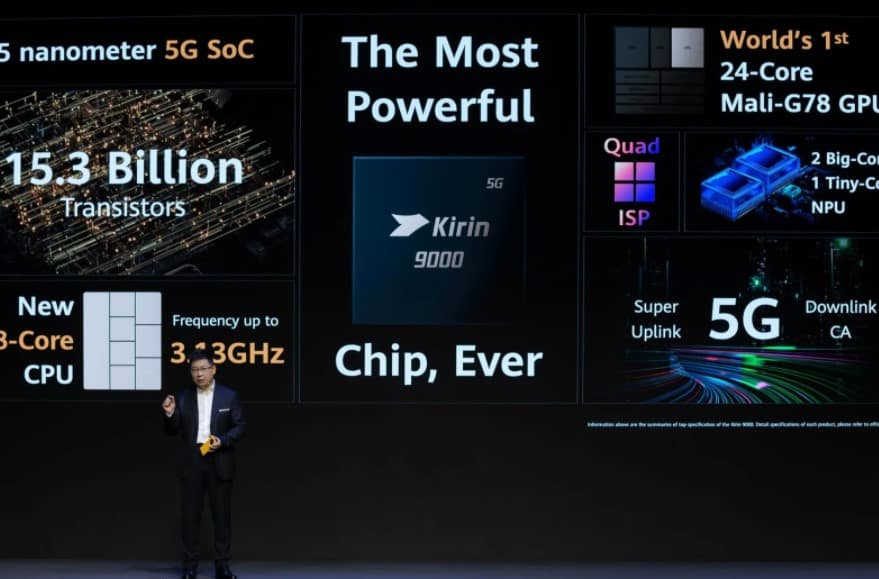Huawei yesterday announced the Mate 40 series alongside the chips that power the new phones.
The Mate 40 Pro and Mate 40 Pro Plus are underpinned by the company’s first 5nm chip, the Kirin 9000. It’s also the world’s first commercially available 5nm chip with a built-in 5G modem.
Kirin 9000 vs Apple A14 Bionic and Snapdragon 865 Plus in the words of Huawei

Huawei took a swipe at Apple by revealing that its flagship chip has 15.3 billion transistors, 30 percent more than Apple’s A14 Bionic chip that fuels the Phone 12 series A higher number of transistors theoretically boosts a chip’s processing power.
The comparison didn’t stop there, and the Chinese giant went on to say that the octa-core CPU on the Kirin 9000 is 10 percent faster than the one on the 7nm Qualcomm Snapdragon 865 Plus, which will soon be succeeded by the company’s first 5nm SoC, the Snapdragon 875.
As opposed to the Snapdragon 875 and the upcoming Samsung Exynos 2100 chips, the Kirin 9000 doesn’t feature Arm’s newly announced Cortex-X1 and Cortex-A78 cores. Instead, it has one Cortex-A77 core clocked at 3.13 GHz, three Cortex-A77 cores with clock speeds of 2.54 GHz, and four Cortex-A55 cores running at 2.05 GHz. This theoretically makes it slower than the other 5nm chips and leaked benchmark scores hint at the same.
The Kirin 9000 features a 24-core Mali G78 GPU, which Huawei claims is 52 percent faster than the Adreno 650 GPU on the Snapdragon 865 Plus.
Now, that’s a one-sided claim, and even if we take Huawei’s word for it, the chip might lose its lead in a couple of months when the new Snapdragon chip is unveiled, as it is rumored to come with the faster Adreno 660 GPU.
On top of that, venerated industry insider Ice Universe says the Mali G78 is power-intensive, which puts it at a disadvantage. Mali GPUs are usually deemed inferior to Qualcomm’s Adreno GPUs, which is perhaps the reason why Samsung is also gearing up to replace them with custom AMD GPUs by 2022.
Someone tested the performance and power consumption of Kirin9000. Mali G78 consumes a lot of power. It is hopeless. I hope Samsung will abandon the ARM Mali GPU as soon as possible. pic.twitter.com/mqrYVpPbJa— Ice universe (@UniverseIce) October 23, 2020
Moving on, the Kirin 9000 also supposedly has a 2.4x faster Neural Processing Unit (NPU) than the Snapdragon 865 Plus.
Huawei also says that the chip’s CPU, GPU, and NPU are 25 percent, 50 percent, and 150 percent more power efficient, respectively, when compared to Qualcomm’s current flagship SoC.
The chip integrates the third-gen Balong 5G modem which the company claims provides 5 times and 2 times faster upload and download speeds, respectively, than the Snapdragon X55 which is paired with the Snapdragon 865 Plus and the A14 Bionic.
Kirin 9000’s Image Signal Processor (ISP) is significantly more powerful than the one on the Kirin 990 and also offers better noise reduction and HDR video processing capabilities.
The Kirin 9000E will power the standard Mate 40
Huawei also announced the Kirin 9000E during the event. It powers the standard Mate 40, which doesn’t have a release date yet.
The Kirni 9000E is basically a stripped-down version of the flagship Kirin 9000 chip, with the same CPU, but a slightly less powerful NPU and GPU.
The two chips could end up being Huawei’s last proprietary SoCs if the US doesn’t lift a ban that has essentially crippled the company’s chip-making subsidiary HiSilicon.

